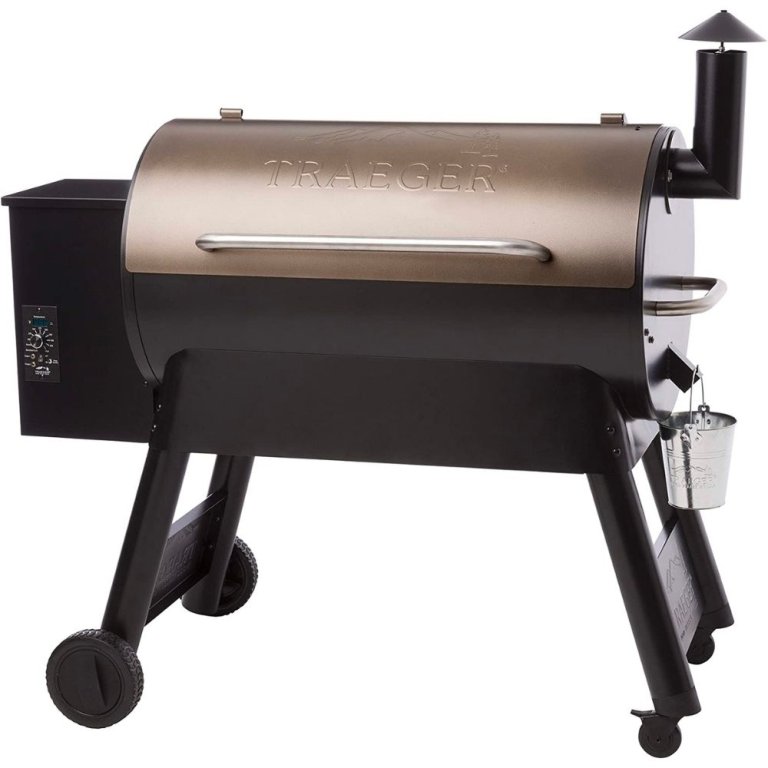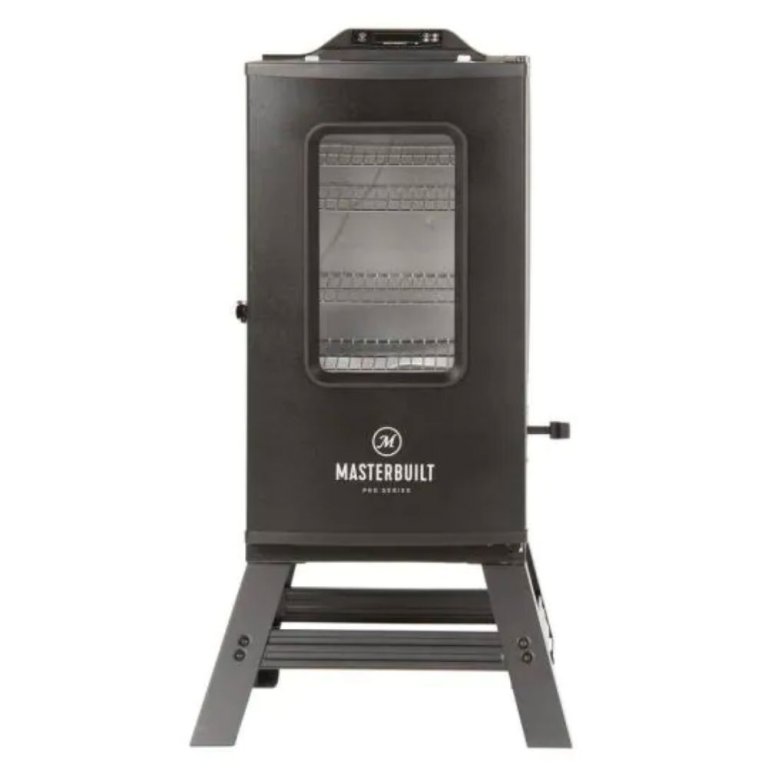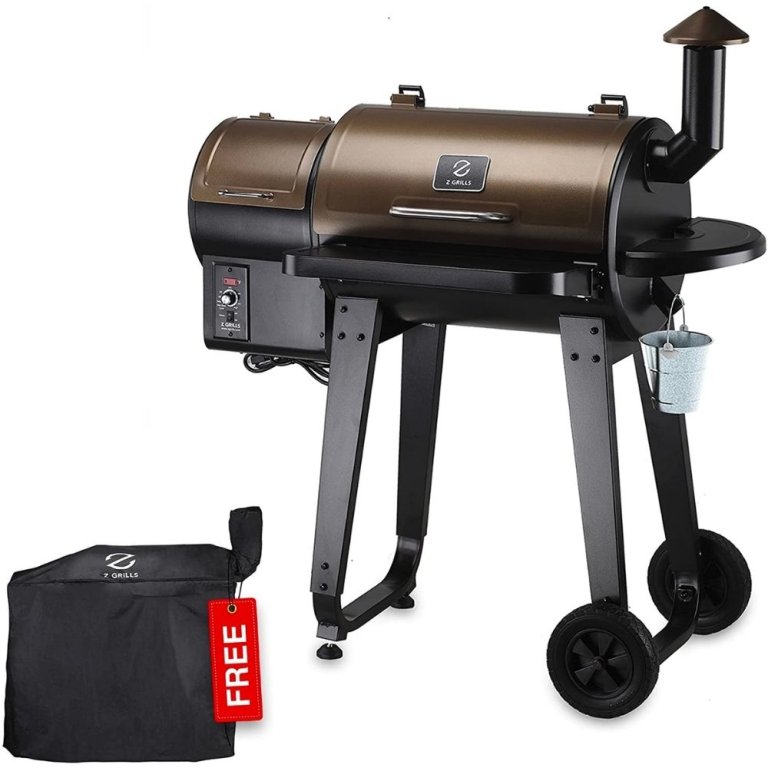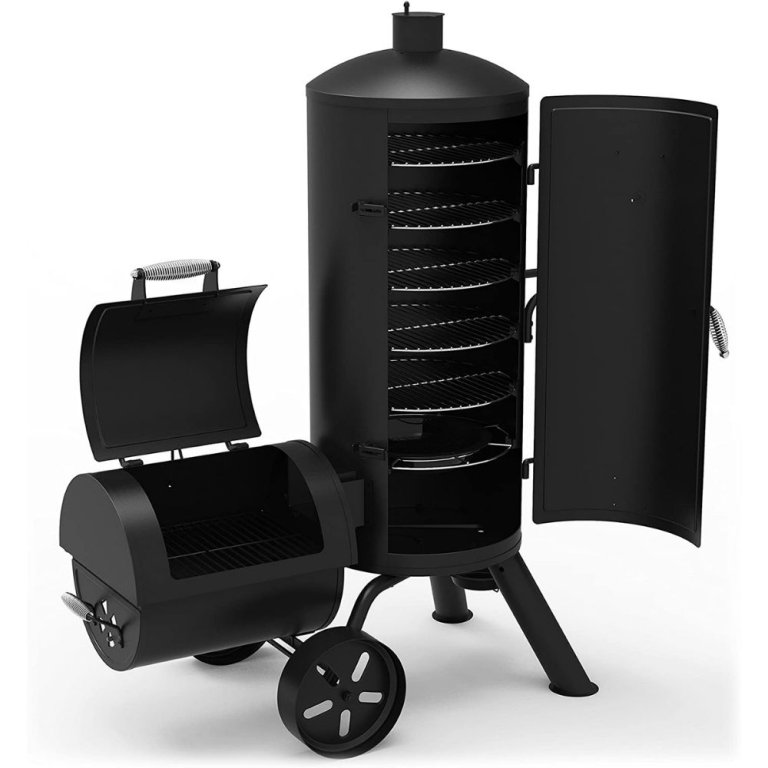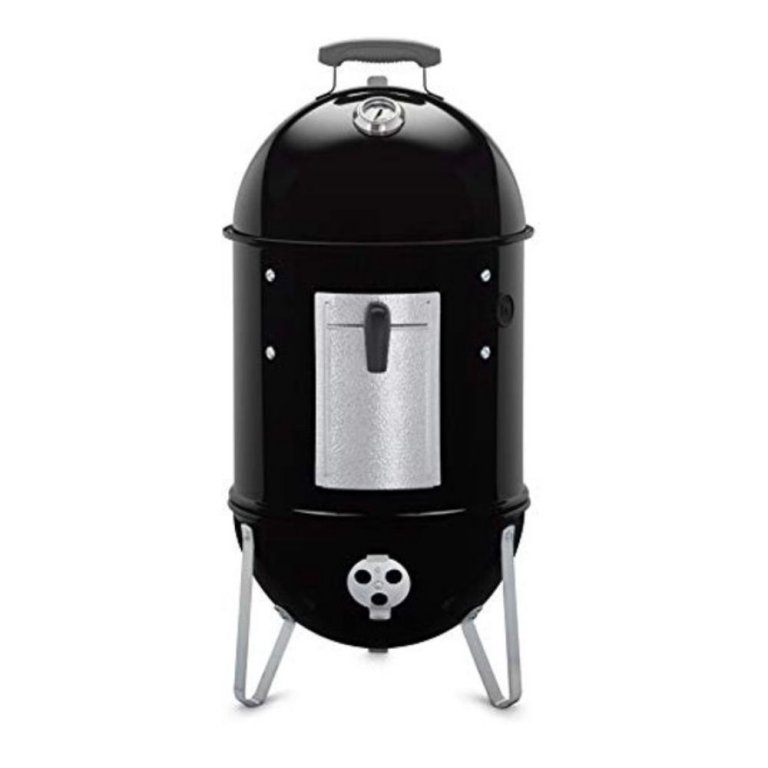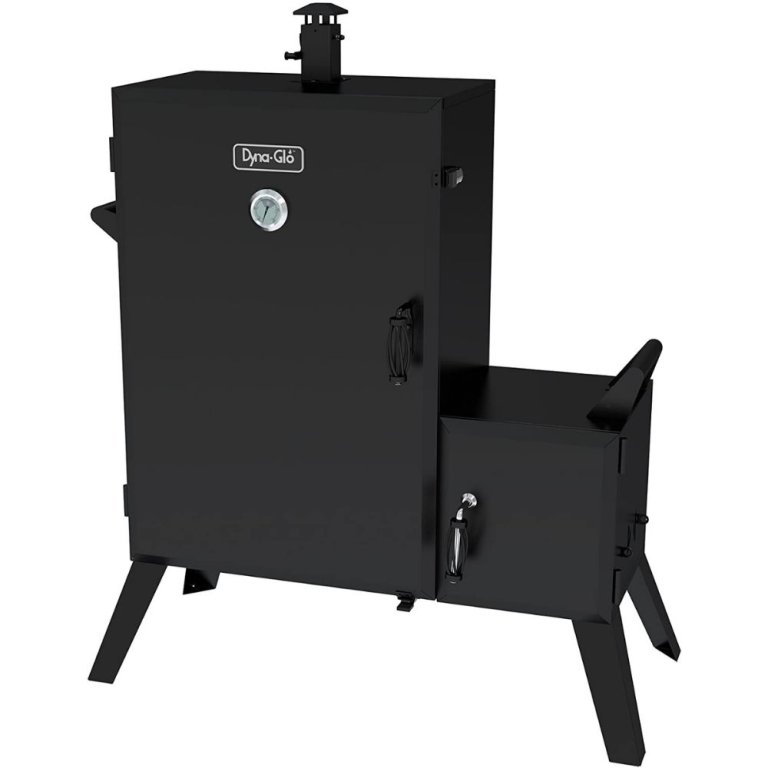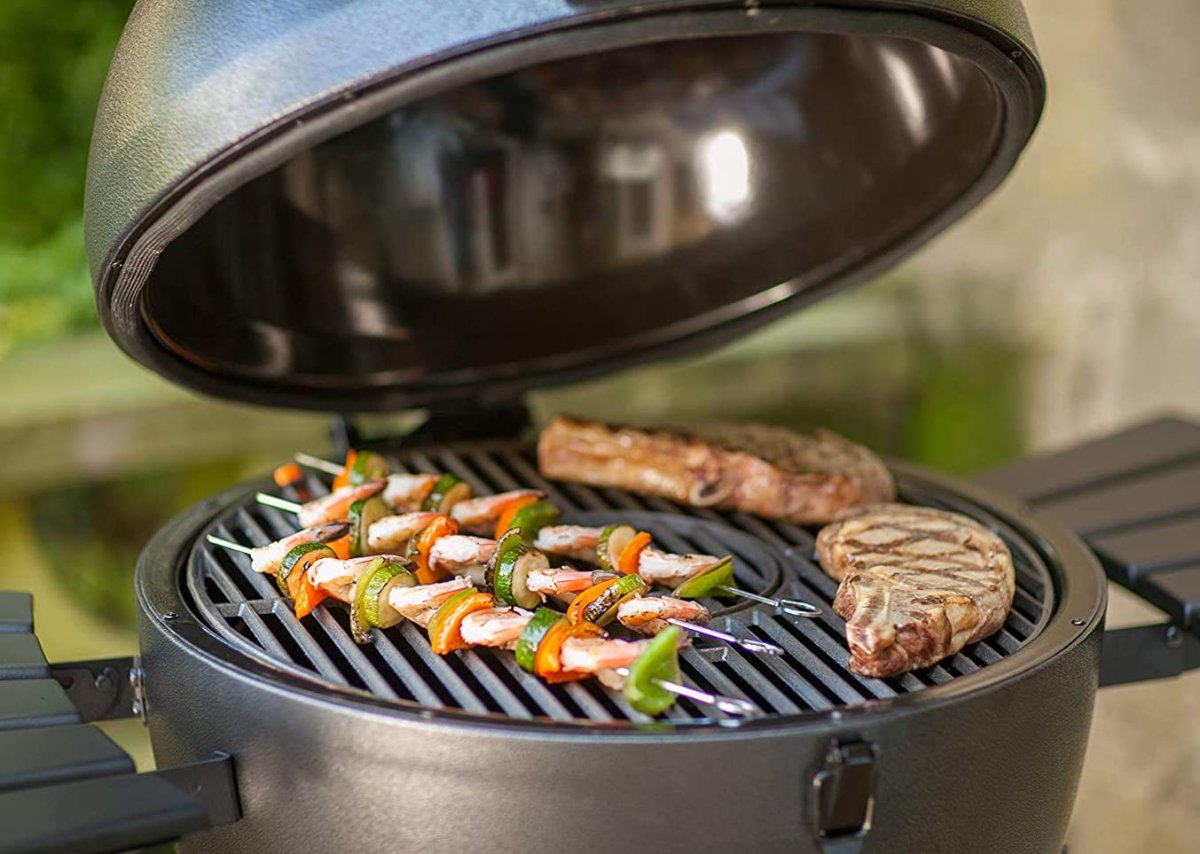
We may earn revenue from the products available on this page and participate in affiliate programs. Learn More ›
Whether you’re tailgating, camping, or enjoying a day out on the deck, smoked meat is a slow-cooked meal worth waiting for. Smoking cuts of meat at about 275 degrees for at least four hours creates a flavorful, juicy flavor profile unlike any other method of cooking.
While all smokers can produce that juicy, smoky flavor in meats, they don’t all achieve it the same way. Fuel type, size, temperature control, safety, and capacity are all important factors to consider when shopping for the best smoker for you. Each of the top picks below was selected after an in-depth review of the market and thorough product vetting.
- BEST OVERALL: Traeger Grills TFB88PZBO Pro Series 34 Pellet Grill
- BEST BUDGET: Char-Griller E16620 Akorn Kamado Charcoal Grill
- UPGRADE PICK: Masterbuilt MB20073519 Bluetooth Electric Smoker
- BEST PELLET: Z Grills ZPG-450A 2020 Upgrade Wood Pellet Grill
- BEST OFFSET: Dyna-Glo Signature Series DGSS1382VCS-D Heavy-Duty
- BEST PORTABLE: Weber 14-Inch Smokey Mountain Cooker
- BEST CHARCOAL: Dyna-Glo DGO1890BDC-D Wide Body Vertical Offset
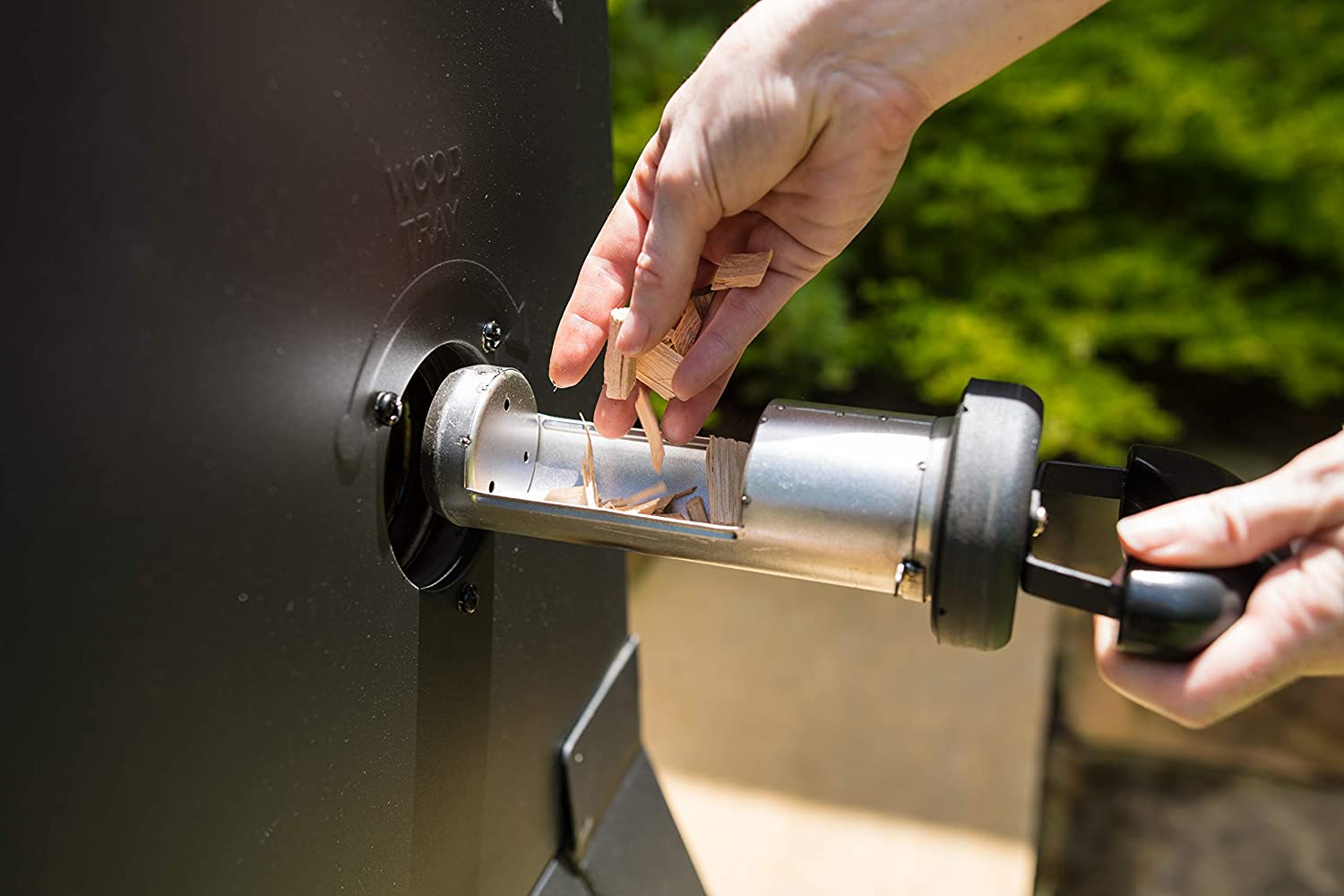
Types of Smokers
“Low and slow” is the mantra of meat-smoking aficionados. All meat smokers work essentially the same way: creating a low heat between 225 and 275 degrees which slowly cooks your meat over the course of several hours.
While the process is essentially the same, smokers achieve that juicy, fall-off-the-bone consistency that barbecue lovers covet in different ways. Read on to learn about the advantages and disadvantages of the different kinds of meat smokers, so you’ll be able to choose the right smoker for your needs.
Charcoal Smokers
Dedicated smoking enthusiasts swear by charcoal smokers. As a fuel source, charcoal produces more smoke than gas or electric, resulting in meat that is marinated in smoky deliciousness.
Charcoal smokers are relatively simple to operate: light a pile of charcoal in the fire chamber, adjust the vents, and monitor that temperature until your meat is ready to eat. The downside of charcoal smokers is that they can build up creosote and other byproducts.
It takes a little getting used to charcoal smokers to attain perfectly smoked meat. Charcoal smokers require the operator to keep a constant eye on the meat because you’re only using vents for temperature control. It may take some trial and error to get the proper fire, vent regulation, and fuel-adding process down. Charcoal smokers are a top choice for those who want hands-on control over every aspect of their smoke.
Gas Smokers
Gas smokers create low, slow heat with propane or natural gas. Lighting a gas smoker is as easy as pressing a button, and controlling their temperature is as simple as turning a knob to adjust the burner flame. Because a gas smoker attaches to a propane tank, most models also take the onus of adding fuel off of the operator. Like charcoal smokers, gas smokers need to be monitored during the smoking process because their temperatures can change very quickly.
Gas smokers come in many sizes, but tend to be smaller than other kinds of smokers. Because they have a smaller capacity, they aren’t suggested if you’re cooking for an army or having a banquet in your backyard. On the upside, their smaller footprint and gas fuel source makes them good choices for aspiring smokers who have minimal outdoor space or live in areas where there are restrictions on charcoal use.
Electric Smokers
Because electric smokers create heat via a heating element inside the smoker, they require an external power source. For this reason, electrical smokers aren’t always optimal for those who plan on using the smoker at a tailgate or while camping. Also, you don’t want electrical cords and plugs to get wet, so it’s not a good idea to use these smokers in bad weather.
What electric smokers lack in portability, they make up for in convenience. They’re popular among novice smoking enthusiasts because they have an automatic internal thermostat, which allows for unparalleled control over temperature. Some electric smokers are even Bluetooth compatible and can be controlled by apps that facilitate remote adjustment and monitoring, making them the right choice if you want succulent meat without putting in a lot of work.
Vertical Smokers
Also known as cabinet or box smokers, vertical smokers have the heat sources under, rather than next to, the cooking chamber. Vertical smokers’ simple design makes them relatively durable and easy to maintain.
The advantage of vertical smokers is they have a small footprint but can hold a lot of meat, thanks to multiple food trays stacked in the cooking chamber. Vertical smokers also have two doors, one to the cooking chamber and one to the fuel chamber. Adding fuel to the fire without sacrificing heat is an advantage that vertical smokers have that many others don’t.
Pellet Smokers
Pellet smokers are the ultimate in set-it-and-forget-it smoking. Pellet smokers are powered by recycled, compressed wood pellets via a digitally-controlled auger. The operator simply enters the desired temperature into the digital control panel. Automated fans, vents, and the auger work in concert to keep the temperature exactly where you want it.
One benefit of using wood pellets in smokers is that they can also roast and bake meats in addition to smoking them. On the downside, pellet smokers require external power, so they’re not so portable. Though these smokers are super convenient, they are made up of lots of complex gadgets and parts, meaning if they break down, repairing them could be costly.
Offset Smokers
In the early 1980s, hungry oil workers developed the original offset smokers with spare 55-gallon drums and a little ingenuity. Offset smokers get their name because the wood- or charcoal-fueled fire is in an external firebox that is located next to, and often set a little lower than, the cooking chamber.
Offset smokers tend to be heavier and larger than other smokers and can accommodate several racks of meat in one cook session. Because they’re so bulky, many offset smokers have wheels so they can be moved and stored easily. Offset smokers are ideal for feeding large groups of people, but take longer to heat up than electric, pellet, or charcoal smokers.
Drum Smokers
Drum smokers take the offset-smoker concept and turn it on its head. These smokers look like vertical oil drums that are rigged with cooking grates and a charcoal burner. You can use drum smokers to grill and even make pizzas. They are easy to assemble and operate, offer excellent temperature control, and have small footprints because of their vertical design.
A high-quality drum smoker is not likely to require a ton of maintenance or repair. The tradeoff for their simplicity is that most don’t come with the bells and whistles associated with higher-tech smokers. A drum smoker is the right choice for someone who wants an easy entry into the world of smoking meats.
What to Consider When Choosing the Best Smoker
Once you’ve determined what sort of meat smoker fits your needs and lifestyle, fine-tune your search by thinking about which features you want your smoker to have. Temperature control, insulation, durability, venting, safety, and size significantly impact the smoking experience.
Size
Meat smokers come in a variety of sizes. Some are the size of a small gas grill, while some professional smokers are so large they need to be towed behind a truck. Smoking enthusiasts who are just cooking for their own families will probably be happy with a small, portable unit.
The size of the smoker itself isn’t the only measurement to consider. Those who are shopping for meat smokers should also consider how much outdoor space you have to maneuver around the unit. The advantage of vertical smokers is that they pack multiple levels of cooking space into a small footprint; horizontal designs take up more space on the deck.
Durability
Smokers are used outside, and not everyone has the space to store them inside when they are not in use. As is the case with any gear that is used outside, make sure the smoker you’re buying is durable and can withstand the elements.
The most durable smokers are those that are built with high-grade construction materials like 304 stainless steel, which reduces corrosion and wear. Also look for quality door seals, which keep heat and smoke in—and rain and snow out. Well-made smokers that are constructed from durable materials are key to a long, productive life of smoking.
Temperature Control
The key to smoking meat is low and slow. Smokers operate at low temperatures over a long period—that’s how the perfect smoky consistency is achieved.
Smokers use myriad methods to regulate temperature, but airflow is key. Most smokers come equipped with adjustable vents, or dampers, allowing operators to control the smoker’s temperature by adjusting oxygen flow through the smoker via these vents.
If your model doesn’t come equipped with one, consider investing in a temperature-control unit for your smoker. These units work by measuring the smoker’s temperature, then blowing air to adjust it to the desired heat.
Insulation
Manipulating the environment inside the smoker is what makes your meat so delicious, but it’s also crucial to keep conditions outside the smoker optimal for smoking.
Because meat smokers are used outdoors, the temperature and humidity levels of the surrounding air influence the environment inside the smoker. This is why some barbecue enthusiasts invest in external insulation blankets to supplement their smoker’s built-in insulation.
Dampers
Dampers are the primary way to control temperature. Like a fireplace, dampers allow the air inside the smoker to escape, but most smokers also come equipped with an intake damper. Adjusting these two changes the airflow through the smoker.
Air comes in through the intake damper and circulates through the firebox. The exhaust damper creates a vacuum effect in the smoker, drawing the smoke past the meat in the cook chamber and back outside. Adjusting the damper openings is the most straightforward way to keep meat at the perfect temperature.
Safety
Safety is a major concern whenever high temperatures are involved. Though smokers’ temperatures are not as high as that of grills, 225 degrees Fahrenheit is still plenty hot to cause injury. Smokers also emit carbon monoxide, and can spit hot grease at their operators.
It’s important to operate a meat smoker well away from structures or overhangs, and always keep a fire extinguisher at the ready when you’re using it. Be sure to clean your smoker carefully after each use to mitigate the possibility of a grease fire within. Finally, consider investing in a good pair of insulated gloves to protect yourself from burns.
Our Top Picks
We’ve spent hours researching the best meat smokers on the market today. Bearing size, fuel type, and other key features in mind, here are our picks for the best smokers for outdoor cooking.
Best Overall
Traeger Grills TFB88PZBO Pro Series 34 Pellet Grill
See ItPros
- Works as a smoker, grill, roaster, braiser, and barbecue
- 2 meat probes included
- 4 built-in wheels
Cons
- No WiFi connectivity included
- Expensive price point
Product Specs
- Type: Pellet smoker
- Size: 884 square inches
- Materials: Powder-coated steel
Fired by wood pellets, Trager’s TFB88PZBO Pro Series unit can be classified as a smoker grill combo that can smoke, grill, bake, roast, braise, and barbecue. Smokers don’t get more versatile than this.
Traeger uses quality, steel construction and a powder-coated finish to help protect this pellet grill from the elements. And its Digital Pro Controller guarantees steady, even heat that lasts as long as the firebox is full of wood pellets. The 884-square-inch cooking surface area is roomy enough to accommodate all but the most oversized banquets. This unit also comes with two meat probes. Unlike some otherpellet grills, this unit does not come with WiFi capability.
Get the Traegar smoker at Amazon, Walmart, and The Home Depot.
Best Budget
Char-Griller E16620 Akorn Kamado Charcoal Grill
See ItPros
- External temperature gauge
- Folding side shelves
- Compact design
- Comes in 3 colorways
Cons
- Heavier than comparable models
- May be difficult to maneuver; only 2 front whee
- Limited temperature control
Product Specs
- Type: Charcoal smoker
- Size: 447 square inches
- Materials: 22-gauge steel
The Char-Griller charcoal grill doesn’t just smoke meat—it can also be used for roasting and grilling. Because it’s a charcoal smoker, the Akorn charcoal grill doesn’t offer much in the way of temperature control beyond a pair of vents and an external temperature gauge, so getting the perfect smoke might take a few tries, but that’s half the fun.
The Akorn’s porcelain-coated, 22-gauge steel body is more durable than comparable ceramic smokers and is the size of a small gas grill. Though its grilling space is not as expansive as that of other smokers at 447 square inches, this charcoal grill does have folding side shelves that’ll easily accommodate your plates and tongs.
The Char-Griller’s insulated design keeps heat in and weather out, and its exterior stays cool to the touch for safe operation around children or pets. This is a versatile little grill overall, though its lack of automation and limited capacity won’t please everyone.
Get the Char-Griller smoker at Amazon, Walmart, and The Home Depot.
Upgrade Pick
Masterbuilt MB20073519 Bluetooth Electric Smoker
See ItPros
- Bluetooth connectivity
- Comes with built-in probe thermometer
- Side-loading wood chop reservoir
Cons
- Not suitable for use in wet climates
- Heavyweight
- No built-in wheels; limited portability
Product Specs
- Type: Electric smoker
- Size: 30 square inches (per shelf)
- Materials: Steel
This electric smoker from Masterbilt takes all of the guesswork out of smoking. A built-in probe thermometer helps ensure perfectly smoked meat every time, but that’s just one of its bells and whistles. This electric smoker also has Bluetooth technology that allows the operator to adjust temperature, lighting, power, and even check the meat temperature from his or her phone.
This smoker’s electric power source makes ignition and maintaining precise temperatures a cinch, and its side-loading wood chip reservoir makes it easy to refuel without losing heat. The downside is that it should not be used in wet conditions. The bottom line is this smoker is a terrific pick if you’re using it close to home, in fair weather, and want succulent meat with no hassle.
Get the Masterbuilt smoker at The Home Depot.
Best Pellet
Z Grills ZPG-450A 2020 Upgrade Wood Pellet Grill
See ItPros
- Can smoke, grill, bake, barbecue, roast, and braise
- Automatic digital control board
- Convection fan system
Cons
- Heavyweight construction
- Limited cooking space compared to similar models
Product Specs
- Type: Pellet smoker
- Size: 450 square inches
- Materials: Stainless steel
The Z Grills ZPG-450A does just about everything for aspiring smokers with more features than average pellet grills. In addition to its smoking capabilities, this machine can grill, bake, barbecue, roast, and braise. Its 450-square-inch grilling surface is spacious enough to prepare a lot of food at once. The automatic digital control board walks users through every step of the cooking process from ignition to temperature control. The ZPG-450A’s wood pellet fuel burns efficiently and cleanly without sacrificing smoky flavor.
This Z Grills pellet grill and smoker boasts a stainless steel construction that protects against the elements and has a convection fan system that regulates its temperature. This is a good smoker for beginners since it is as close as it gets to a set-it-and-forget-it machine, which can be an advantage or a disadvantage, since those who seek a more hands-on smoking experience might be disappointed at how much the machine does by itself.
Get the Z Grills smoker on Amazon and at Walmart.
Best Offset
Dyna-Glo Signature Series DGSS1382VCS-D Heavy-Duty
See ItPros
- Built-in offset firebox
- Runs on charcoal or wood
- External temperature gauge
- 2 built-in wheels
Cons
- Non-insulated construction
- May be difficult to maneuver
Product Specs
- Type: Vertical smoker
- Size: 1,382 square inches
- Materials: Heavy-gauge steel
This vertical griller boasts a whopping 1,382-square-inch cooking surface for those big barbecue parties, and it has an offset firebox that allows the user to add fuel without sacrificing temperature. The Dyna-Glo can run on either charcoal or wood, and its vertical design provides for good air and smoke flow throughout the cooking chamber. As a bonus, the external temperature gauge allows you to monitor the temperature without opening the door.
This smoker is made of a heavy-gauge metal, however, it is not insulated. But a little extra sealant around the gaps makes a good offset smoker with lots of upside.
Get the Dyna-Glo smoker on Amazon.
Best Portable
Weber 14-Inch Smokey Mountain Cooker
See ItPros
- 14-inch cooking diameter
- Max temperature of 190 degrees Fahrenheit
- Easy to assemble
- Lightweight
Cons
- Door is a little flimsy
- iGrill2 remote thermometer system sold separately
- No wheels included
Product Specs
- Type: Charcoal smoker
- Size: 286 square feet
- Materials: Heavy-gauge porcelain-enameled steel
The diminutive Weber Smokey Mountain is an excellent choice for smokers on the go. Its 14-inch diameter offers 286 square inches of grilling space. It is fueled by charcoal, so you won’t have to worry about external power sources while you’re on tailgating or camping adventures. It is easy to clean this Weber Smokey Mountain as it is made of heavy-gauge, porcelain-enameled steel.
The door on the Weber Smokey Mountain cooker is a little flimsy, which leads to some smoke leakage. Still, it does an admirable job keeping the heat inside. It is compatible with the iGrill2 remote thermometer system (not included) for those who want a high-tech component on a reliable, portable smoker.
Get the Weber smoker at The Home Depot and Ace Hardware.
Best Charcoal
Dyna-Glo DGO1890BDC-D Wide Body Vertical Offset
See ItPros
- 6 adjustable grates
- Charcoal chamber and grate included
- Removable ash pan
- Stainless steel thermometer included
Cons
- No enameled water bowl included
- Heavyweight construction
- Not portable
Product Specs
- Type: Vertical offset smoker
- Size: 1,890 square inches
- Materials: Porcelain-enameled steel
Dyna-Glo’s big boy smoker does one thing, and it does it well. With a whopping 1,890 square inches of grilling space, it is big enough to smoke enough meat for a king’s banquet. Six adjustable cooking grates accommodate just about any flesh or fowl. This offset smoker includes a charcoal chamber, charcoal grate, and removable ash pan for cleaning.
The vertical design and porcelain-coated charcoal tray make for efficient operation. The offset design keeps the heat well away from the meat, while filling the cooking chamber with smoke. Its built-in stainless steel thermometer helps you gauge its interior temperature, but learning the perfect vent settings for your meat is up to you.
Get the Dyna-Glo smoker on Amazon and at The Home Depot.
Our Verdict
It can be difficult to select the right smoker for your intended use when there are so many options available. One of the best pellet smoker options overall is the Traeger smoker with its 884 square inches of cooking space, powder-coated steel construction, and functionality as a smoker, grill, roaster, braiser, and barbecue.
Alternatively, for those looking for a charcoal smoker, the Char-Griller smoker has 447 square inches of cooking space, a 22-gauge steel construction, and an external temperature gauge.
How We Chose the Best Smokers
For the master griller or the beginner, the right smoker can make all the difference when cooking ribs, pork shoulder, or brisket. We researched the most sought-after smokers in their respective categories and discovered that pellet, charcoal, vertical, electric, and offset models are favored for their large cooking surfaces, portability, and special features.
The above list includes effective smokers with 30 to 1,890 square inches of cooking space and heavy-gauge and porcelain-enameled constructions for ampe cooking and long lifespans. Most of these options also come with built-in wheels, temperature gauges, and durable racks for cooking. For the charcoal and pellet models, many brands include removable ash pans or fireboxes for easy post-use cleanup, or convection fan systems for ventilation.
Smoker grill combos are also included in the above list as they can smoke, grill, bake, roast, braise, and barbecue. While select models come with sturdy feet, most of the above picks come with built-in wheels for portability. For added convenience, some brands also include adjustable racks, digital control boards, or even Bluetooth connectivity.
FAQs
Smoking is a fun way to cook, and the time you put into it pays off. But as with any new endeavor, novice smokers probably have a lot of questions. Peruse our frequently asked questions section to get the answers you need before purchasing a smoker.
A regular smoker uses charcoal to cook the meat and create smoke from the wood chips to flavor the meat. Electric smokers use electric heating elements to cook the meat and create smoke from the wood chips to flavor the meat.
Smokers use a variety of methods to generate a heat of about 275 degrees Fahrenheit. The juiciest, smokiest barbecued meats are achieved by cooking them over low heat for a long period of time.
For best results, spray the inside of your smoker with cooking oil (grapeseed or canola oil work great), and heat at a high temperature for a few hours before you put your first cut of meat inside.
It takes about 20 minutes after adding the wood chips before they start smoking enough to produce flavor.
When used in a smoker, charcoal burns slowly for a long time. A 15-pound bag of charcoal can burn for up to 15 hours inside the firebox, which is usually plenty of time to smoke most meats.
Yes, in fact, it’s a good idea to use wood in a charcoal smoker. Using different types of wood, such as hickory or cherry, creates different flavors in the meat. Just make sure to mix the wood with the best charcoal for smoking instead of adding wood alone to ensure a long burn time. An ash pan is also a good idea to help collect the ashes as the wood burns.



